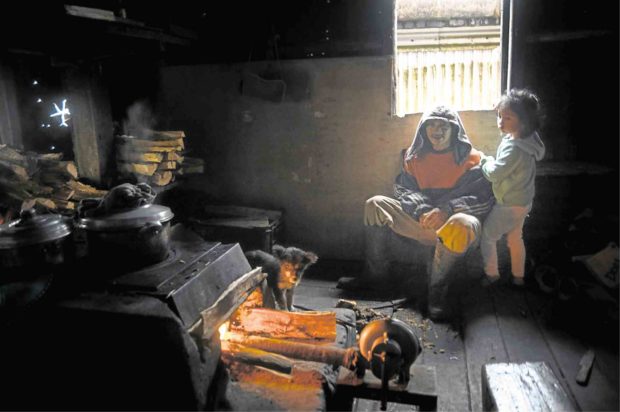
Members of a family warm themselves in Buguias town, Benguet province, where cases of frost, or “andap,” in vegetable farms had waned but remained to be a concern. —RICHARD BALONGLONG
LA TRINIDAD, Benguet — Farmers were starting to cope with falling temperatures here although the rate of frost has been slowing down.
Occurrences of frost, or thin sheet of ice, that sometimes blankets vegetable farms in Atok and Kibungan towns have become less frequent every year, according to provincial agriculturist, Lolita Bentres.
Temperature in nearby Baguio City dropped recently to 11.4 degrees Celsius, but this did not generate frost, locally known as “andap,” Bentres said. Temperatures were usually 3 to 4 degrees lower in higher-elevated communities in Atok and Kibungan.
Main supplier
At the start of 2017, frost occurred in 270 hectares of vegetable farmlands in the province, she said.
Benguet supplies 80 percent of the country’s salad vegetables like carrots, cabbages, beans and lettuce.
But farmers in frost-vulnerable towns have learned to use techniques that help reduce damage, Bentres said.
Many have resorted to what they call “tunnel farming,” or the use of plastic sheets common in greenhouse farming, to prevent the forming of ice sheets that destroy leafy vegetables, she said.
Farmers had also learned to time their planting so the most critical phase of vegetable growth does not coincide with the frost season from December to February.
‘Rain birds’
In Atok, farmers use impact sprinklers, popularly known as “rain birds” after the American company that introduced it here in the 1960s, according to municipal agriculturist Cherry Sano.
Before sunrise, farmers go to the farms to sprinkle vegetables and thaw the ice forming on the plants’ surface.
Indigenous knowledge passed on from generations has also been proven to be effective in reducing frost.
Sano said farmers look for weather patterns, like heavy wind during extreme cold, because these mean the chances of frost occurrence were slim. Frost occurs in mountainous areas with low air circulation.
Bentres also said frost becomes a menace to farmers when it is used to manipulate prices. Traders and middlemen sometimes reduce the volume of vegetables they transport to Metro Manila and raise their prices, citing frost when in fact there was even a glut in production, she said. KARLSTON LAPNITEN